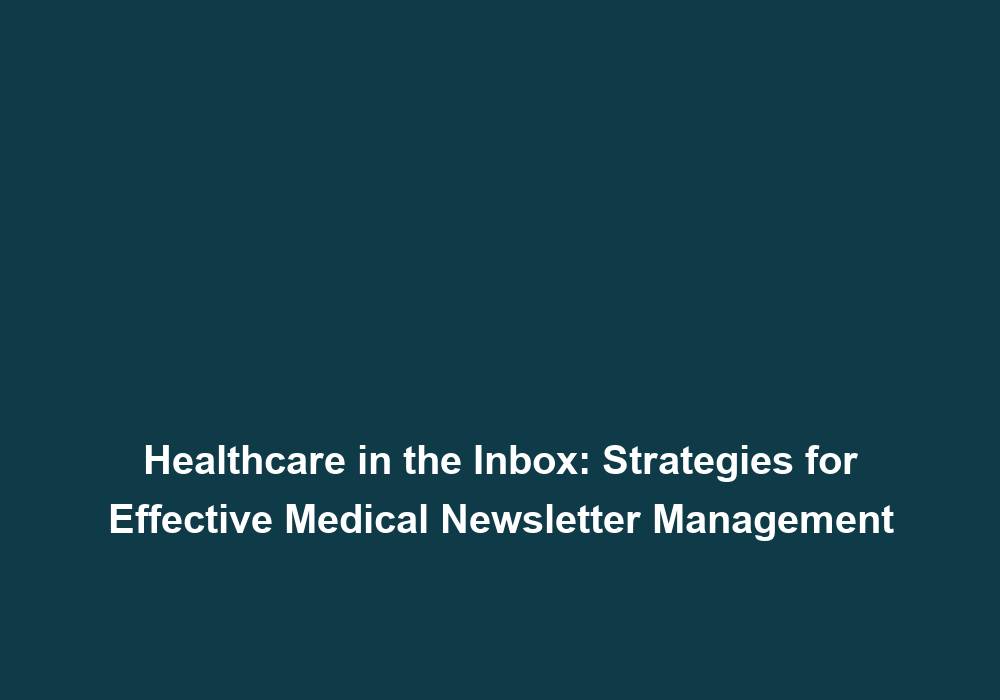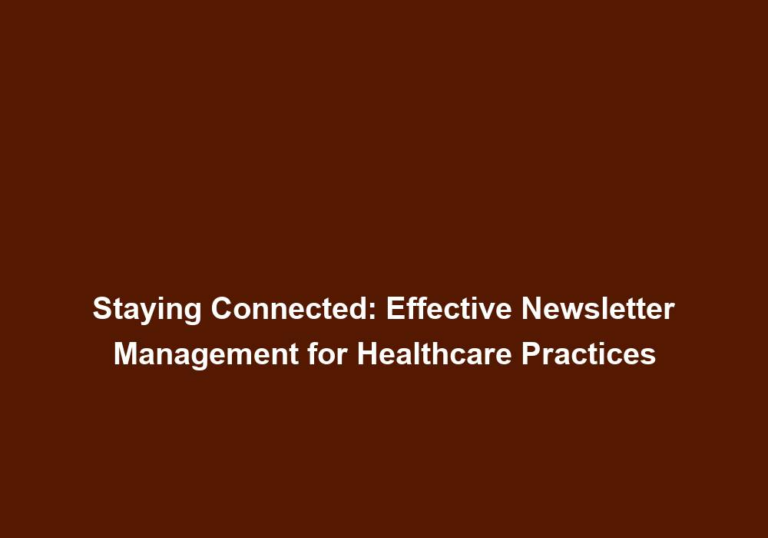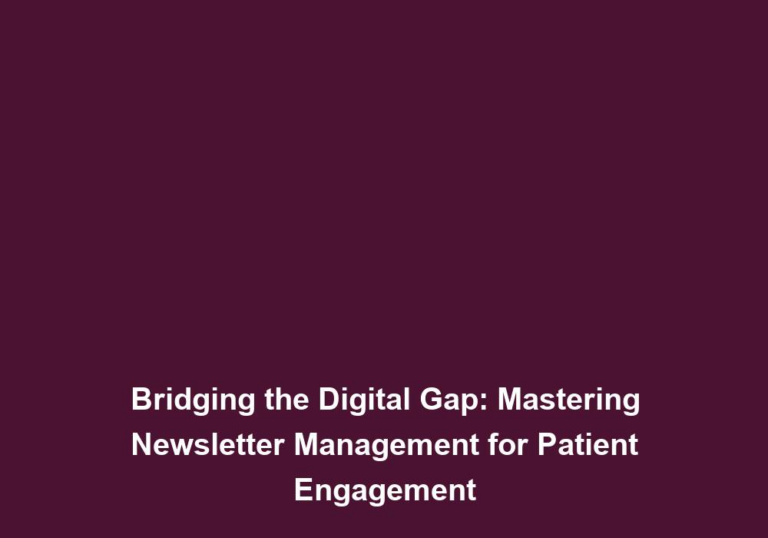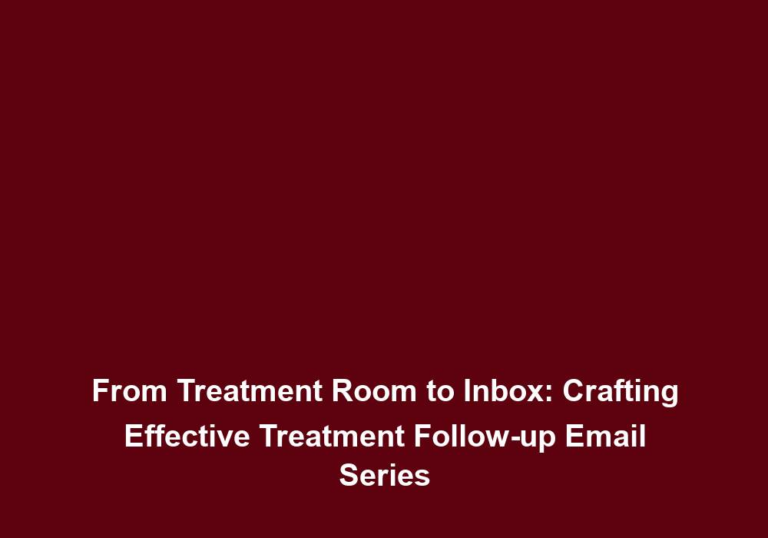Healthcare in the Inbox: Strategies for Effective Medical Newsletter Management
In the digital age, email newsletters have become an essential tool for healthcare organizations to reach out to their audience and keep them informed about the latest medical advancements, health tips, and industry updates. However, managing these newsletters effectively requires careful planning, engaging content, and a clear understanding of your target audience. In this article, we will explore some strategies to help you optimize your medical newsletter management and maximize its impact.
The Importance of a Well-Defined Target Audience
Before diving into the intricacies of medical newsletter management, it is crucial to identify and understand your target audience thoroughly. By considering the demographics, interests, and needs of your subscribers, you can tailor the content to suit their preferences and establish a stronger connection. Here are some points to consider when defining your target audience:
-
Demographics: Determine the age, gender, location, and other relevant characteristics of your subscribers. This information will help you understand their specific needs and interests.
-
Healthcare Professionals vs. Patients: Differentiate between your target audience of healthcare professionals and patients. Their backgrounds and knowledge levels vary, so it’s important to create content that is relevant and valuable to each group.
-
Interests and Preferences: Conduct surveys or ask for feedback to gather insights into the topics and types of content that interest your audience. This will help you create more engaging and targeted newsletters.
Crafting Compelling Content
A successful medical newsletter relies on the quality of its content. Here are some key tips to create compelling content that resonates with your readers:
1. Clear and Concise Writing
To ensure that your message is accessible to all readers, regardless of their medical background, write in a straightforward and easily understandable manner. Avoid jargon or complex medical terms. Use plain English to convey your information effectively.
2. Engaging Headlines and Subheadings
Attention-grabbing headlines and subheadings make it easier for readers to navigate through the newsletter and locate the information they are interested in. Make them concise, descriptive, and compelling. Consider the following techniques:
- Pose intriguing questions in your headlines to pique readers’ curiosity.
- Use power words that evoke emotion or create a sense of urgency.
- Highlight the main benefits or takeaways of the content in your subheadings.
3. Relevant and Timely Information
To keep your readers engaged, provide valuable information that is relevant to their needs and interests. Stay updated with the latest medical research, industry trends, and healthcare news. Timeliness is key to establishing your credibility and keeping your readers informed about the most recent developments. Consider the following tactics:
- Research and include recent studies or breakthroughs in your newsletter.
- Cover trending topics in the healthcare industry and provide insightful analysis.
- Highlight any advancements or innovations in medical treatments or technologies.
4. Visual Appeal
Incorporating visually appealing elements, such as images, graphs, and infographics, can enhance the overall appeal of your newsletter. Visuals not only break up the text but also help convey complex information in a more digestible and engaging manner. Consider the following tips:
- Use high-quality images that are relevant to the content and help illustrate key points.
- Create infographics or charts to present data or statistics in a visually appealing format.
- Incorporate graphs or diagrams to explain medical concepts or processes.
5. Incorporate Case Studies and Success Stories
Utilize real-life case studies and success stories to demonstrate the effectiveness of certain medical treatments or interventions. This not only adds credibility to your newsletter but also provides practical insights that can benefit your readers. Consider the following approaches:
- Share stories of patients who have successfully overcome medical challenges.
- Highlight case studies that showcase the positive outcomes of specific treatments.
- Include testimonials from patients or healthcare professionals who have experienced the benefits of certain interventions.
6. Expert Contributions and Interviews
Featuring expert contributions and interviews with renowned healthcare professionals adds authority and diversity to your newsletter. Seek out industry experts and invite them to share their perspectives or advice on relevant topics. Consider the following strategies:
- Conduct interviews with specialists in different medical fields to provide expert insights.
- Invite guest contributors to write articles or provide expert opinions on specific subjects.
- Collaborate with healthcare professionals to create content that offers practical tips or recommendations.
Personalization and Segmentation
Personalization is a powerful strategy to enhance the effectiveness of your medical newsletter. By segmenting your subscriber list and delivering targeted content based on their specific interests or needs, you can significantly improve engagement and conversion rates. Consider the following techniques:
- Segment your subscribers based on their demographics, interests, or past engagement with your newsletters.
- Send personalized emails addressing each subscriber by their name to create a sense of individuality.
- Customize the content of your newsletters to match the preferences of different segments within your audience.
Frequency and Consistency
Finding the right balance between newsletter frequency and consistency is crucial. Bombarding your subscribers’ inboxes with daily emails may lead to unsubscribes or lower open rates. On the other hand, irregular or infrequent newsletters may cause your audience to lose interest. Strive for consistency by setting a regular schedule, whether it’s weekly, bi-weekly, or monthly, and ensure each issue provides valuable and engaging content. Consider the following tips:
- Determine the optimal frequency by analyzing your subscribers’ engagement and feedback.
- Plan your content ahead of time to ensure a consistent flow of information.
- Create an editorial calendar to organize your newsletter topics and maintain a consistent publishing schedule.
Effective Call-to-Action (CTA)
A well-crafted call-to-action motivates your readers to take the desired action after reading your newsletter. Whether it’s scheduling an appointment, signing up for an event, or accessing further resources, clearly communicate the desired action and make it easy for your audience to follow through. Use compelling language and provide a direct link or contact information to facilitate the process. Consider the following techniques:
- Use action verbs to create a sense of urgency and encourage immediate response.
- Highlight the benefits of taking the desired action to motivate your readers.
- Provide clear instructions and make it easy for readers to complete the desired action, such as including a clickable button or a direct link.
Tracking and Analyzing Metrics
To gauge the effectiveness of your medical newsletter, it is essential to track and analyze relevant metrics. By utilizing email marketing analytics tools, you can gain insights into your subscribers’ behavior and preferences, allowing you to refine your content and improve future newsletters. Consider the following metrics:
- Open Rates: Measure the percentage of subscribers who open your newsletters. This indicates the effectiveness of your subject lines and overall engagement.
- Click-through Rates: Track the percentage of subscribers who click on links or CTAs within your newsletters. This helps measure the relevance and appeal of your content.
- Conversion Rates: Analyze the percentage of subscribers who complete the desired action, such as making a purchase or scheduling an appointment. This indicates the effectiveness of your CTAs and overall newsletter impact.
- Subscriber Growth: Monitor the growth of your subscriber base over time. This helps evaluate the success of your newsletter acquisition strategies.
Conclusion
Effective medical newsletter management requires a well-defined target audience, compelling content, personalization, consistency, and a clear call-to-action. By following these strategies, healthcare organizations can enhance their communication efforts, establish strong connections with subscribers, and provide valuable information that resonates with their audience. Remember, a well-crafted newsletter has the potential to drive engagement, foster trust, and ultimately contribute to better healthcare outcomes.







